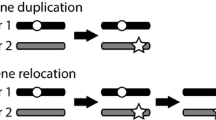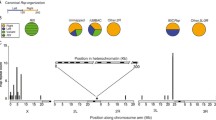Abstract
The Drosophila melanogasterspecies subgroup is a closely-knit collection of eight sibling species whose relationships are well defined. These species are too close for most evolutionary studies of euchromatic genes but are ideal to investigate the major changes that occur to DNA in heterochromatin over short periods during evolution. For example, it is not known whether the locations of genes in heterochromatin are conserved over this time. The 18S and 28S ribosomal RNA genes can be considered as genuine heterochromatic genes. In D. melanogasterthe rRNA genes are located at two sites, one each on the X and Y chromosome. In the other seven sibling species, rRNA genes are also located on the sex chromosomes but the positions often vary significantly, particularly on the Y. Furthermore, rDNA has been lost from the Y chromosome of both D. simulansand D. sechellia, presumably after separation of the line leading to present-day D. mauritiana.We conclude that changes to chromosomal position and copy number of rDNA arrays occur over much shorter evolutionary timespans than previously thought. In these respects the rDNA behaves more like the tandemly repeated satellite DNAs than euchromatic genes.
Similar content being viewed by others
References
Ashburner, M., 1989. Drosophila: A Laboratory Handbook. Cold Spring Harbor Laboratory Press, New York.
Ault, J.G. & C.L. Rieder, 1994. Meiosis in Drosophilamales. I. The question of separate conjunctive mechanisms for the XY and autosomal bivalents. Chromosoma 103: 352–356.
Caccone, A., E.N. Moriyama, J.M. Gleason, L. Nigro & J. Powell, 1996. A molecular phylogeny for the Drosophila melanogastersubgroup and the problem of polymorphism data. Mol. Biol. Evol. 13: 1224–1232.
Cariou, M.L., 1987. Biochemical phylogeny of the eight species in the Drosophila melanogastersubgroup, including D. sechelliaand D. orena. Genet. Res. Camb. 50: 181–185.
Danilevskaya, O.N., C. Tan, J. Wong, M. Alibhai & M.L. Pardue, 1998. Unusual features of the Drosophila melanogastertelomere transposable element HeT-A are conserved in Drosophila yakubatelomere elements. Proc. Natl. Acad. Sci. USA 95: 3770–3775.
Davis, A.W., J. Roote, T. Morley, K. Sawamura, S. Herrmann & M. Ashburner, 1996. Rescue of hybrid sterility in crosses between D. melanogasterand D. simulans. Nature 380: 157–159.
Hennig, W., B. Link & O. Leoncini, 1975. The location of the nucleolus organizer regions in Drosophila hydei. Chromosoma 51: 57–63.
Hirai H., M.T. Yamamoto, R.W. Taylor & H.T. Imai, 1996. Genomic dispersion of 28S rDNA during karyotypic evolution in the ant genus Myrmecia(Formidicae). Chromosoma 105: 190–196.
Hilliker, A.J., R. Appels & A. Schalet, 1980. The genetic analysis of D. melanogasterheterochromatin. Cell 21: 607–619.
Lachaise, D.L., M-L. Cariou, J.R. David, F. Lemeunier, L. Tsacas & M. Ashburner, 1988. Historical biogeography of the Drosophila melanogasterspecies subgroup. Evol. Biol. 22: 159–225.
Lee, W.H. & T.K. Watanabe, 1987. Evolutionary genetics of the Drosophila melanogastersubgroup. I. Phylogenetic relationships based on matings, hybrids and proteins. Jpn. J. Genet. 62: 225–239.
Lemeunier, F. & M. Ashburner, 1984. Relationships within the melanogasterspecies subgroup of the genus Drosophila(Sophophora). IV. The chromosomes of two new species. Chromosoma 89: 343–351.
Lemeunier, F., J.R. David, L. Tsacas & M. Ashburner, 1986. The melanogasterspecies group, pp. 147–256 in The Genetics and Biology of Drosophila, edited by M. Ashburner, H.L. Carson & J.N. Thompson. Vol. 3e, Academic Press, New York.
Livak, K.J., 1984. Organization and mapping of a sequence on the Drosophila melanogasterX and Y chromosomes that is transcribed during spermatogenesis. Genetics 107: 611–634.
Lohe, A.R., 1981. The satellite DNAs of Drosophila simulans. Genet. Res. Camb. 38: 237–250.
Lohe, A.R. & P.A. Roberts, 1990. An unusual Y chromosome of Drosophila simulanscarrying amplified rDNA spacer without rRNA genes. Genetics 125: 399–406.
Lohe, A.R. & A.J. Hilliker, 1995. Return of the H-word (heterochromatin). Curr. Opin. Genet. Dev. 5: 746–755.
Lohe, A.R., E.N. Moriyama, D-A. Lidholm & D.L. Hartl, 1995. Horizontal transmission, vertical inactivation, and stochastic loss of mariner-like transposable elements. Mol. Biol. Evol. 12: 62–72.
Long, E.O. & I.B. Dawid, 1980. Repeated genes in eukaryotes. Annu. Rev. Biochem. 49: 727–764.
McKee, B.D., 1996. The license to pair: identification of meiotic pairing sites in Drosophila. Chromosoma 105: 135–141.
Moschetti, R., C. Caggese, P. Barsanti & R. Caizzi, 1998. Intraand interspecies variation among Bari-1 elements of the melanogasterspecies group. Genetics 150: 239–250.
Palopoli, M.F., A.W. Davis & C.I. Wu, 1996. Discord between the phylogenies inferred from molecular versus functional data: uneven rates of functional evolution or low levels of gene flow? Genetics 144: 1321–1328.
Pimpinelli S., M. Berloco, L. Fanti, P. Dimitri, S. Bonaccorsi, E. Marchetti, R. Caizzi, C. Caggese & M. Gatti, 1995. Transposable elements are stable structural components of Drosophila melanogasterheterochromatin. Proc. Natl. Acad. Sci. USA 92: 3804–3808.
Roiha, H., J.R. Miller, L.C. Woods & D.M. Glover, 1981. Arrangements and rearrangements of sequences flanking the two types of rDNA insertion in D. melanogaster. Nature290: 749–753.
Schlotterer, C., M-T. Hauser, A. von Haeseler & D. Tautz, 1994. Comparative evolutionary analysis of rDNA regions in Drosophila. Mol. Biol. Evol. 11: 513–522.
Stuart, W.D., J.G. Bishop, H.L. Carson & M.B. Frank, 1981. Location of the 18S/28S ribosomal RNA gene in two Hawaiian Drosophilaspecies by monoclonal immunological identification of RNA.DNA hybrids in situ. Proc. Natl. Acad. Sci. USA 78: 3751–3754.
Tartof, K.D., 1979. Evolution of transcribed and spacer sequences in ribosomal RNA genes of Drosophila. Cell 17: 607–614.
Tautz, D., J.M. Hancock, D.A. Webb, C. Tautz & G.A. Dover, 1988. Complete sequences of the rRNA genes of Drosophila melanogaster. Mol. Biol. Evol. 5: 366–376.
Author information
Authors and Affiliations
Rights and permissions
About this article
Cite this article
Lohe, A.R., Roberts, P.A. Evolution of DNA in Heterochromatin: the Drosophila Melanogaster Sibling Species Subgroup as a Resource. Genetica 109, 125–130 (2000). https://doi.org/10.1023/A:1026588217432
Issue Date:
DOI: https://doi.org/10.1023/A:1026588217432




